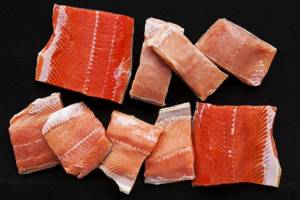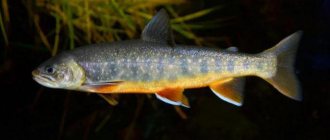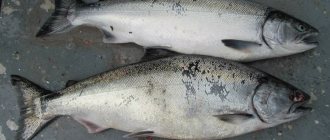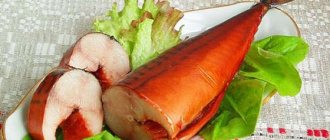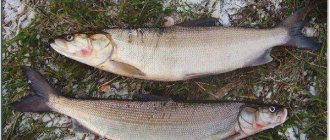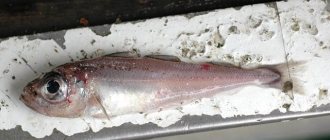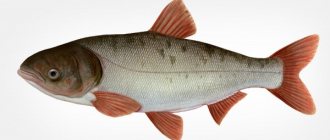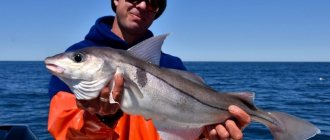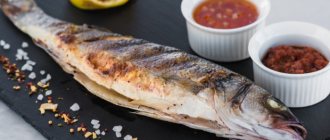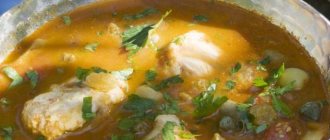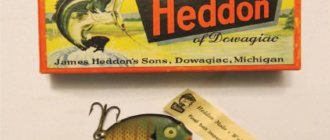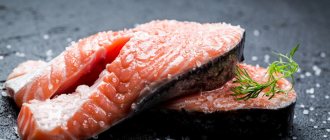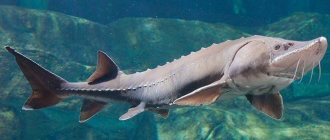Description
Salmon
Salmonidae (lat. Salmoninae) is a subfamily of fish from the salmon family of the same name (lat. Salmonidae).
They have features common to the entire salmon family. They differ from graylings in having a shorter and smaller dorsal fin, which contains from 10 to 16 rays. They have a brighter color than whitefish.
The commonly used names in everyday life “salmon” and “trout”, contrary to the stereotype, do not correspond to any type of fish. These are collective names of either an entire family or subfamily (typical of the name “salmon”), or a large group of species united by one property (trout).
Actually, salmon is considered to be salmon in general, or salmon during spawning. On the other hand, the term “salmon” appears in the name of more than a dozen different species of fish from different subfamilies, as well as in the name of two genera - Noble salmon and Pacific salmon.
The same situation is observed with the Latin names - salmo (salmon) and trutta (trout).
Scientific classification is also difficult. Due to the variability and wide distribution of species of the salmon family, scientists have developed both different classifications (see Salmonidae) and different names (in addition to national ones, including purely scientific Latin synonyms) for the same species of this family. Moreover, the same Latin (scientific) name in different classifications can correspond to different species.
Appearance
Adults have a body length of up to 2 m, their maximum weight ranges from 68 to 70 kg. In terms of body structure, they resemble representatives of herring fish. It is noteworthy that all salmonids were once classified in this order, but later they were separated into an independent order. Salmon looks like this:
- long body, laterally compressed;
- round comb scales;
- pelvic fins in several rays, localized in the central part of the abdomen;
- dorsal fins (true and anal).
According to the description of the order, salmonids are characterized by the presence of a so-called adipose fin of miniature size. The dorsal fin may consist of 10-16 rays. For comparison, graylings have an average of 20 rays. The swim bladder is usually connected to the esophagus through a special channel.
The oral cavity is protected by four bones. In females, during the breeding season, eggs easily move from the ovary to the body cavity. The intestine has an impressive number of pyloric branches. Most members of the family have transparent eyelids. The skeletal part of many species is not completely ossified.
There are 3 subspecies of salmon
Distribution and habitats
Pacific salmon are found in the upper horizon of the world's oceans. Here this fish appears during the migration period. They swim here either from the depths or from the coastal shallows. Salmon come here to gain weight. And later he goes to spawn either back to the shallows, or into freshwater rivers or lakes where he was born.
Distribution and habitats of salmon
Pacific salmon live in schools, forming huge biomass, sometimes even exceeding the number of permanent inhabitants of the ocean. The main representatives of Pacific salmon include chum salmon, pink salmon, coho salmon, chinook salmon and masu salmon. Most often, this fish comes to the northern part of the Pacific Ocean, where it gathers in huge schools and actively feeds. Pacific salmon go to spawn in the rivers of the Russian Far East, as well as in the reservoirs of Korea, Japan, North America and even Taiwan. At different times of the year, salmon live in different places, however, even with the onset of winter cold, they do not go further than subarctic waters.
Atlantic salmon, along with other species of this fish, are both resident and anadromous. Anadromous salmon are typically found in the North Atlantic Ocean. From here they go to spawn in many rivers, ranging from Spain to the Barents Sea. The lakes of Norway, Sweden, Finland and Russia are rich in the living form of this salmon.
Salmon are a very valuable commercial fish. Therefore, it is actively bred in fish farms. Some farms breed it for the purpose of organizing sport fishing, while others breed it for its taste. This is not surprising, because the meat of this fish is very tasty and tender, and is considered a delicacy. This fish is great for many types of dishes.
Where are salmon found?
Is salmon a river or sea fish? It’s a difficult question. The breed belongs to freshwater inhabitants, swims in the seas, but prefers to spawn in rivers. Often when moving them from one water source to another, the fish lose their lives.
The main habitat of salmon fish is the Pacific and Atlantic Oceans. In the Atlantic Ocean, salmon is most often represented by salmon; in the Pacific Ocean and off the coast of Russia (Kamchatka, Sakhalin, Kuril Islands), sockeye salmon, pink salmon, and chinook salmon are found. The fish is also found in the middle and northern latitudes of the Northern Hemisphere, and most often spawns in Kamchatka.
On the territory of the Russian Federation, salmon can be found in the basin of the Arctic Ocean, the Barents Sea, the Sea of Okhotsk, in Chukotka and in the Amur River. Americans, Canadians and Japanese catch this salmon in the Aleutian Islands, Alaska, Cape Krusenstern and the Kent Peninsula. These fresh water sources are characterized by low temperatures and a poor food supply, so the fish swim into the sea.
By the way, read more on this topic: Salmon Carpaccio
Age and size
Average weight 7-8 kg; sometimes reaches a weight of more than 30 kg. To spawn, it enters the rivers Neva, Kola, Northern Dvina, Pechora, etc. A special form of salmon, close to trout, lives in the Black Sea. This salmon rises into the rivers Bzyb, Kodori, Rioni. Its average weight is 6-7 kg, occasionally reaching 24 kg.
Caspian salmon is distributed mainly on the western and southern coasts of the Caspian Sea. Average weight 12-13 kg. It spawns in the rivers Kure, Terek, and Samur.
In the large lakes - Onega and Ladoga - the lake form of salmon is found. Average weight is 3-4 kg, maximum - 10-12 kg. Spawns in the rivers Shuya, Vodla, Vuoksa, Svir.
Description and characteristics
Despite the fact that salmon and trout are similar in appearance, they differ in the size of their scales, growth rate and dimensions. The maximum size of Atlantic salmon is 1.5 m and weighs more than 40 kg. The same brown trout, or ishkhan, does not grow larger than 15-20 kg even in suitable conditions.
To learn more:
What kind of fish is chum salmon?
External features of the taxon:
- elongated fusiform body;
- a small adipose fin located close to the tail;
- medium, tightly fitting scales (114-130 pieces in the lateral line);
- randomly scattered x-shaped dark pigment spots covering the gill covers and the upper part of the body;
- bluish or greenish color of the back;
- light belly;
- large terminal mouth with strong small teeth;
- silvery flattened sides.
The basic color changes significantly during spawning. The fish becomes darker, the fins turn black, the body acquires a bronze tint, and the spots turn red. Mature males are characterized by a protruding hook on the lower lip, which fits into a special notch on the elongated maxillary bone.
The maximum lifespan of Atlantic salmon is 11-13 years, but usually in nature this figure is much lower - 5-7 years. During this time, he manages to gain weight of 4-10 kg in salt water and go to spawn several times.
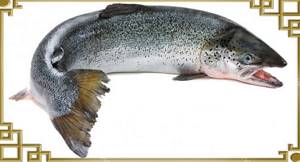
Lifestyle
Salmon Spawning Salmon are typical migratory fish: they constantly live in the sea or lake and rise into rivers only to reproduce.
The life of different species of salmon is generally similar, but at the same time, the biology of each species, and even of the same species, but in different rivers, has its own characteristics. Usually, having reached the age of 4-6 years, salmon enters fast rapids rivers and rivers, sometimes rising upstream for hundreds of kilometers. The timing of salmon entry into rivers varies: “spring” salmon rise in the summer and early autumn just before spawning. Salmon of the “winter” form enter rivers in late autumn or early spring and spend about a year in them before spawning.
To stop in the river during the pre-spawning period, salmon choose mainly shallow, fast places with sandy, pebble or rocky soil. Most often these are areas located near spawning grounds, above rapids and rifts.
During their stay in the river, the salmon “loses”: its color darkens, and a hook appears on its jaw, especially pronounced in the male. The color of the meat becomes paler and the amount of fat decreases.
Spawning in northern rivers begins in the second half of September or in October at water temperatures from 0 to 8°. In the south, salmon spawn in October - January at water temperatures from 3 to 13°. The eggs are laid in a hole dug in the ground and, after spawning is complete, covered with sand and pebbles.
After spawning, the salmon becomes even thinner and weaker, and part of the salmon herd dies. The percentage of fish deaths is not the same everywhere. It is usually determined by the amount of turning return to spawning, which varies for different rivers from 9 to 28 percent. The surviving individuals partially roll into the sea or lake, and partially remain in the river until spring. In the river, spawning salmon do not move far from their spawning areas, but move to deeper and quieter areas.
In the spring, young salmon hatch from the spawned eggs, which in appearance resemble pied trout. In the river, juvenile salmon spend from 1 to 5 years (usually 2-3 years), growing during this time to 15-18 cm. They stay in fast places and feed on lower crustaceans, insect larvae and the insects themselves. Sometimes salmon catch earthworms. Therefore, an angler who fishes with a fishing rod in “salmon” rivers must be able to distinguish young salmon and, when caught, immediately release them back into the river. Before rolling into the sea or lake, salmon lose their speckles and acquire a silvery color. Having rolled into the sea or lake, salmon begins to feed intensively and grows quickly, reaching a weight of several kilograms within one to two years. The main food of salmon in the sea and lake is crustaceans and small fish.
The behavior of salmon during migration and spawning changes: at the beginning of the rise, it plays intensely, jumping high out of the water; As spawning approaches, jumps above the water become less frequent and lower. Spawning and spawning salmon almost never jump out of the water, but only “melt,” that is, they show their dorsal fin or the end of their tail above the surface of the water. The game of salmon is most intense in calm weather, and in early autumn and spring the game is more intense at dawn, and in late autumn - in the middle of the day.
What do salmon eat?
In natural wild conditions, juvenile salmon, like trout, feed on aquatic larvae and adult insects in rivers; juvenile salmon spend different years in rivers and fresh water, from one to five years. And when they go out into the bays and seas, salmon feed mainly on small fish, sprat and herring from the herring family, sand lance, smelt and crustaceans, as well as three-spined stickleback. The diet of salmon depends on its habitat.
Types of salmon
Types of salmon The salmon family is a large fish family with several species:
- Char (American, Arctic, kunja)
. These are quite similar fish in appearance, differing only in their habitat. Loaches are called the orderlies of reservoirs - they feed on a wide variety of foods: from Pacific salmon caviar to stickleback. Char, in addition, is an object of fishing. - Pink salmon.
Pink salmon is a small silver-colored salmon, reaching no more than 50-60 cm in length. It feeds on fairly high-calorie food, consisting of fry, small fish and crustaceans. Pink salmon lives in almost the entire northern half of the globe, which has led to commercial interest in this fish - Ishkhan.
Ishkhan lives in Lake Sevan - another proof that salmon are able to adapt to any habitat. This is a most valuable delicacy fish, weighing up to 15 kilograms. - Chum salmon.
Far Eastern salmon or chum salmon is the sovereign master of the Pacific expanses. Massive chum salmon fishing is carried out both in Russia and the United States. Chum salmon caviar is quite large – up to 9 mm in diameter. - Coho salmon, Chinook salmon.
The white color of the scales gave these species other names - “silver salmon”, “white fish”. As for Chinook salmon, this is the king of salmon, as the Americans call this fish for its excellent taste. However, the fishing for this valuable salmon is very scarce due to its small numbers. - Christivomer North American.
This salmon lives only in lakes and has two forms: the cristomere, which lives on the surface of the water, and the cristomere, which lives on the bottom. - Brown trout.
Brown trout is listed in the Red Book of Russia. This is an anadromous salmon fish, valued for the amazing taste of its meat and caviar. The habitats of brown trout cover European rivers, the White, Baltic, Black and Aral Seas. - Lenok.
Lenok is more a fishing target for individual fishermen than for industrial fishing companies. This is a small salmon weighing two to three kilograms, although there are larger specimens - up to 8 kilograms. - Salmon (Clark's, Steelhead).
This salmon does not go far from spawning and tries to live in small channels. Its appearance is very exotic - for the red spots on its throat it was nicknamed the “cut throat” salmon. But this does not in any way affect the taste of the fish - it is excellent in any form. - Red salmon.
Sockeye salmon or red fish differs from other salmon in the color of its meat - it is deep red in color, and not pinkish. Sockeye salmon loves cold waters - it can rarely be found in water with a temperature of more than 1-2 degrees Celsius. - Salmon.
Noble salmon or salmon is a large salmon fish up to one and a half meters long and weighing up to forty kilograms. Unusually tasty tender meat made it a royal fish and one of the best fish delicacies. - Sima.
Mazu or Shima is a native of the Asian Pacific Ocean. This salmon is amazing: not only for the wonderful taste of its dense meat, but also for its ability to form residential freshwater forms as needed. - Taimen (Danube, Sakhalin)
. Taimen is a very large salmon fish, reaching 1.5 meters in length. It lives in large numbers in all rivers of Siberia and clean, cold lakes, preferring them to access to the open sea.
Classification of varieties
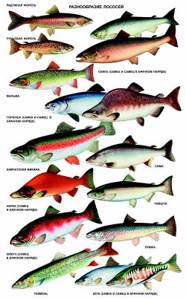
And that's not all. In addition to the two genera of salmon, the salmon family also includes taimen, lenok, grayling, char, whitefish and palia. But, I repeat, here we are talking only about salmon - Pacific (Oncorhynchus) and noble (Salmo). Below I will give a brief description and the main differences between these genera. Below are the most striking representatives of salmon.
Pink salmon

Pink salmon grows up to 60 centimeters in length and is colored silver. It lives in almost the entire northern part of the globe. The smallest and most widespread and fastest-growing representative of the Pacific salmon genus.
Chum salmon
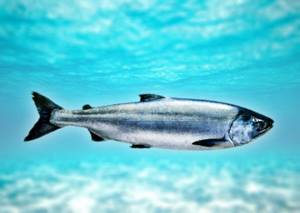
Chum salmon is a Far Eastern salmon. Widely distributed in the Pacific Ocean. It is a popular fishing target. It has very large caviar, more than 8 millimeters in diameter.
Coho salmon, Chinook salmon
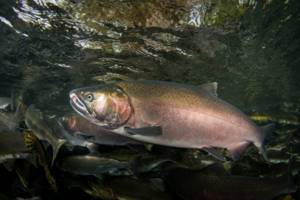
The fish has white scales. It has very tasty meat. It is not very popular in fishing due to the small number of individuals.
Red salmon
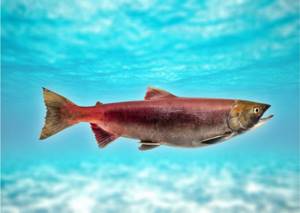
This variety is also called red fish because of its red-colored meat. Prefers cold water. Rarely occurs if the air temperature is above 1 degree Celsius.
Salmon

A very large species of salmon. It grows up to 1.5 meters in length and gains weight of more than 40 kilograms. It is considered one of the best delicacies. People call it the king fish.
Salmon fishing
Salmon fishing is not easy. Firstly, you can’t find salmon everywhere and not always; sometimes they are not in places that seem very attractive. On every river there are places where a particularly steep descent begins; Usually there is a good stretch in front of such a steep drop. In these reaches, salmon almost always rest before rushing upward.
The rise of salmon occurs at night or under the cover of turbid water.
On strong rapids you can observe salmon jumping out with enormous force and speed against the current. Among the residents of the Sochi region, many engage in salmon fishing with spinning rods; Recently, this method of fishing in the south has become more and more widespread. Catching salmon weighing 8-10 kg is not regarded as a special occasion here; Anglers often pull out a pound of fish or more. Very often there are gear breaks. Salmon fishing
The peculiarity of fishing is that you have to try to catch it in every hole, despite the difficulties of moving from one hole to another. When approaching the shore, you need to throw the spoons so that they fall almost on the opposite bank, with the expectation that you can move the spoon across the current longer. You can throw the bait a little higher than where the fisherman is staying so that at the beginning of the movement the spoon moves near the bottom of the river, obliquely towards the current. But this is a very risky technique, since if the spoon falls too high, the current will land it on the bottom and press it against the rocks.
Snatches usually occur either at the moment the spinner falls, or when the spinner is carried along an arc by the current and thrown almost to the surface. At this time, in an effort to prevent the spinner from reaching the surface, you need to reduce the rotation speed.
If after ten throws there is no bite, then you need to move on to the next hole. It is necessary to keep in mind that salmon very often grab onto the weight, so you should attach an anchor to the weight or fish with heavy spoons (“Devons”, “Snakes”, “Salmon”, etc.), and replace the weight with an anti-twist.
When the characteristics of a given river and the methods of using a spoon in a strong current have been sufficiently studied, it is better to move on to fishing for large boulders and snags. Although such fishing is accompanied by the risk of landing a spoon, it is worth taking this risk. In addition, you need to very skillfully guide the caught salmon in order to prevent it from reaching the snag.
The salmon bite is particularly strong. Simultaneously with the blow, he quickly rushes with a spoon in his mouth up or downstream, but very rarely leaves the hole. It is impossible to restrain this jerk on the rod, no matter how strong it is. You need to quickly put the reel on the brake and raise the end of the rod higher. However, you cannot limit yourself to the reel brake; you also need to brake with the fingers of your left hand. Sometimes you have to brake the spool with your right hand, and only hold the rod with your left hand.
Having reached a shallow place, the salmon turns back and rushes against the current at the same speed. Now it’s easier to hold him back, but you shouldn’t do this, since he gets tired faster in this direction. Having reached a hole or large stone, the salmon stops, and the fisherman gets the impression that the fish has fallen into the hole. It is very difficult to move salmon from the pit.
After such a struggle, the fisherman, having rested, must carefully inspect his tackle and check the strength of the carabiners, knots, leash, and especially the strength of the line around the leash.
The best time to catch salmon is early morning. This fish takes until almost noon; then for several hours, until the evening, bites occur only as an exception, and in the evening the salmon again begins to take well.
The best weather for fishing is before a thunderstorm or heavy rain.
In good weather, local fishermen recommend fishing with a tackle, assuring that salmon catch better on dead fish; but this has to be doubted, since salmon were usually caught better with lures than with rigs with dead fish.
Notes
- Reshetnikov Yu. S., Kotlyar A. N., Rass T. S., Shatunovsky M. I.
Five-language dictionary of animal names. Fish. Latin, Russian, English, German, French. / under the general editorship of academician. V. E. Sokolova. - M.: Rus. lang., 1989. - P. 69. - 12,500 copies. — ISBN 5-200-00237-0. - Atlantic salmon (English) in the FishBase database.
- Mikhin V.S., Speicher A.O.
About spawning grounds and natural spawning of salmon // Scientific-Technical. Bulletin VNIORH. - 1957. - No. 5. - P. 39-42. - Dikhnich A.V.
Biological basis for the formation of broodstocks of Atlantic salmon
Salmo salar
L. in hatchery conditions. — Dissertation for an academic degree. Ph.D. - 2004. - 128 p. - Draft order of the Ministry of Natural Resources of Russia “On approval of Lists of fauna objects included in the Red Book of the Russian Federation and excluded from the Red Book of the Russian Federation” - Ministry of Natural Resources and Ecology of the Russian Federation. www.mnr.gov.ru. Retrieved October 5, 2021.
- AquAdvantage Salmon FDA.
- Transgenic salmon nears approval.
Salmon in cooking
Salmon is considered an exquisite delicacy with a pleasant taste and delicate aroma. There are many types of its preparation. Salmon is good both as appetizers (ceviche, carpaccio, marinated salmon) and in various main courses.
Salmon makes excellent soups, mousses, soufflés, pates, cutlets, it is used as a filling for pies and casseroles, added to salads... And fried salmon and kebabs made from this fish have long become culinary classics. Fish of the salmon family is an undisputed favorite of Japanese cuisine, since it is salmon that is included in the most popular sushi, sashimi and rolls.
The nutritional value
100 g of salmon contains 68.5 g of water, 19.84 g of protein, 6.34 g of fat and no carbohydrates at all. Its calorie content is 142 kcal per 100 g of weight. The benefits of this fish are undeniable. It contains selenium, B vitamins, vitamins A, E, D, biotin, folic acid. Salmon is also rich in microelements and beneficial substances such as iodine, phosphorus (200 mg), potassium (490 mg), copper (250 mcg), sodium (44 mg), magnesium (29 mg), calcium (12 mg), also in it contains iron, manganese and zinc.
Salmon contains Omega-3 fatty acids in abundance, which are involved in the regulation of cholesterol levels, blood pressure, and also reduce the symptoms of asthma, rheumatoid arthritis and depression.
Salmon: calories and nutritional value
Salmon contains fish oil - vitamin D combined with a large amount of phosphorus, which helps strengthen bones. Omega-3 fatty acids improve brain function.
100 grams of salmon contain 206 kilocalories. The product contains 12 grams of fat, 20 grams of protein.

Nutrients contained in salmon:
- vitamin B12;
- niacin;
- phosphorus;
- thiamine;
- vitamin A.
By the way, read more on this topic: Salmon Ceviche
Salmon in medicine and cosmetology
Salmon is sometimes called "fish for the mind." Omega-3 fatty acids contained in salmon meat, in addition to lowering cholesterol, reducing the risk of cardiovascular disease, also increase IQ (intelligence quotient).
Eating salmon reduces the risk of malignant neoplasms, strokes, arthritis, diabetes and Alzheimer's disease, normalizes the functioning of the brain, heart and kidneys, and prevents the formation of atherosclerotic plaques in blood vessels. The potassium and calcium contained in salmon help strengthen the musculoskeletal system.
Salmon caviar and salmon oil (fish oil) are used in the cosmetics industry to produce anti-aging and nourishing products for face, hair and body care.
Contraindications
Despite all its beneficial properties, salmon is not recommended for pregnant women and nursing mothers. The fact is that the meat of some types of fish of this family may contain mercury. Its tiny amount does not have a negative effect on the body of an adult, but it can seriously harm newborns and embryos.
Due to the fact that salmon is considered a fatty fish, this product should not be abused by people who suffer from chronic diseases of the stomach, liver or intestines, as well as obesity.
The benefits and harms of salmon sparkle
For a long time, salmon caviar was considered unsuitable for consumption. Until the end of the 19th century, it was simply thrown away along with its offal. The French “tasted” caviar. Over time, so-called caviar houses even began to appear in France. These establishments were very popular among the nobility. Caviar here was served on silver trays, and the tasting process itself became almost a ritual.
In Rus', caviar was an expensive delicacy that was brought from the East. Only rich nobles and individuals of royal blood could afford such pleasure.
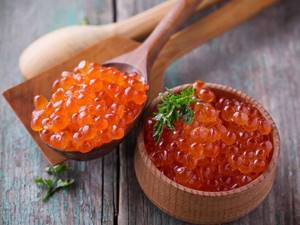
Today this product is considered a real delicacy. Appetizers with red caviar become an integral part of the festive table. A sandwich with butter and caviar has already become traditional. Seafood is also used to decorate fish and meat dishes.
Benefits of salmon caviar:
- Almost 30% of it consists of protein, which is perfectly absorbed by the body.
- Seafood contains a lot of healthy fats and amino acids, which are necessary for the full functioning of all organs and systems.
- Due to the large amount of vitamins in the composition, it strengthens the immune system and increases the body's resistance to stress.
- Omega-3 stimulates brain activity and improves memory. It is this substance that helps preserve youth and beauty.
- Due to the high content of retinol, it can be used to prevent hypovitaminosis A.
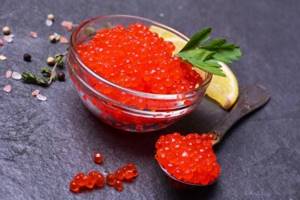
Contraindications and features of consuming salmon caviar:
- For individual intolerance to seafood.
- For hypertension and urolithiasis, it is not recommended to consume too much caviar due to its high salt content.
- Due to the high content of fats, proteins and amino acids, red caviar should be consumed in doses, no more than five teaspoons per day, otherwise digestive problems may occur.
Breaded
We will need: half a kilo of salmon fillet, vegetable oil, 3 eggs, a glass of milk, a glass of flour. Cut the fillet into small pieces. Season with salt and pepper, adding your favorite spices. Set aside for soaking for half an hour. Meanwhile, make the batter. Beat raw eggs with salt. Add milk and mix. Gradually add flour, stirring. The batter is ready. Take pieces of chum salmon fillet and dip each of them into the prepared mixture. Fry on both sides (about 5 minutes each) in hot oil in a frying pan or in a deep fryer.
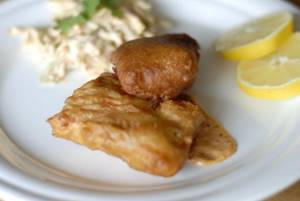
Chum salmon - wild salmon
A widely distributed and valuable fish for fishing in many countries. Reaches a length of a meter and a mass of 15 kilograms. It lives in the Arctic and Pacific oceans, near America - from Canada to California (Monterey Bay). In the last century, its populations were reduced due to overfishing in Japan. However, today we can say that the reserves of this species have been practically restored; chum salmon can be seen in one form or another on the shelves of large supermarkets and specialized fish stores.
